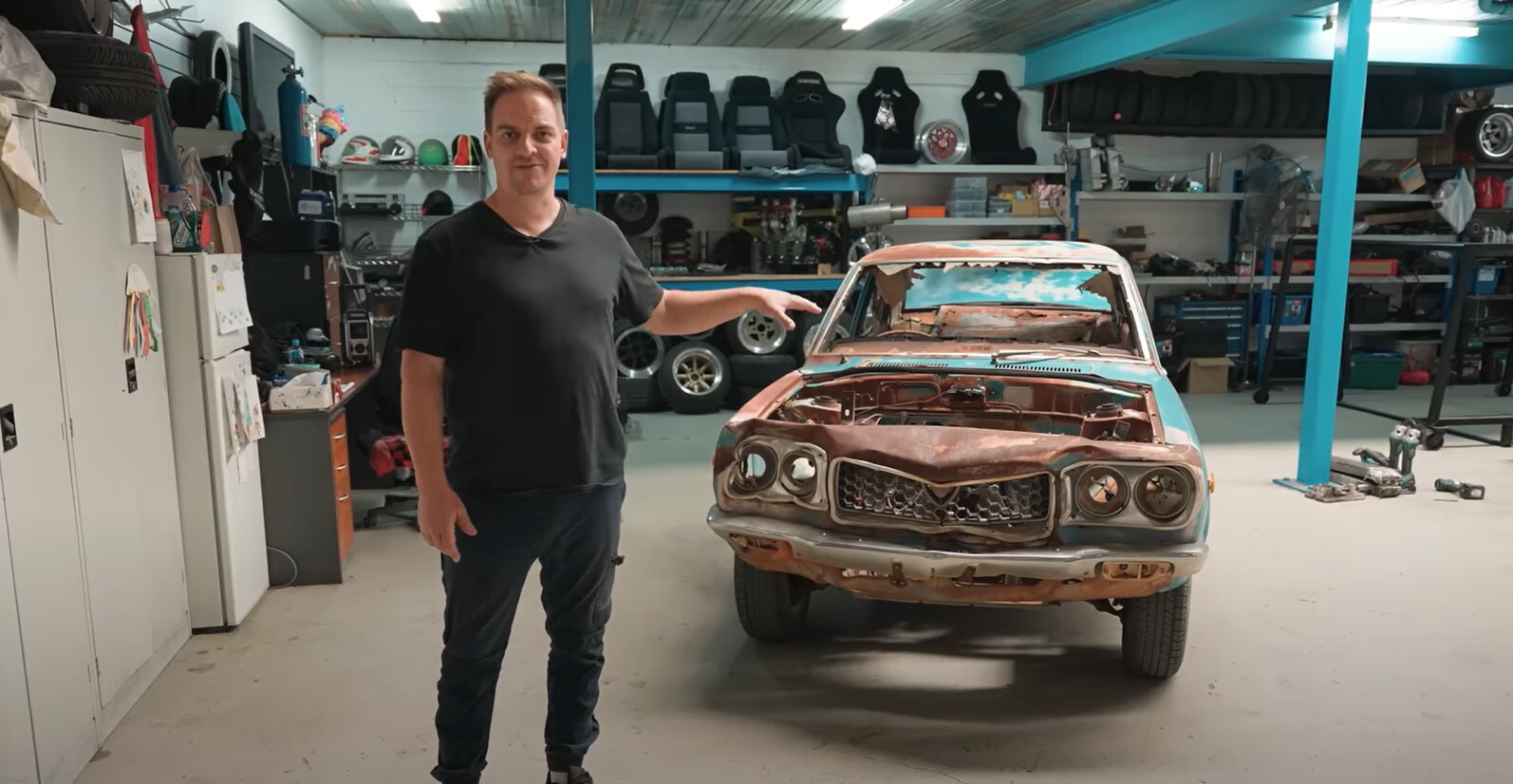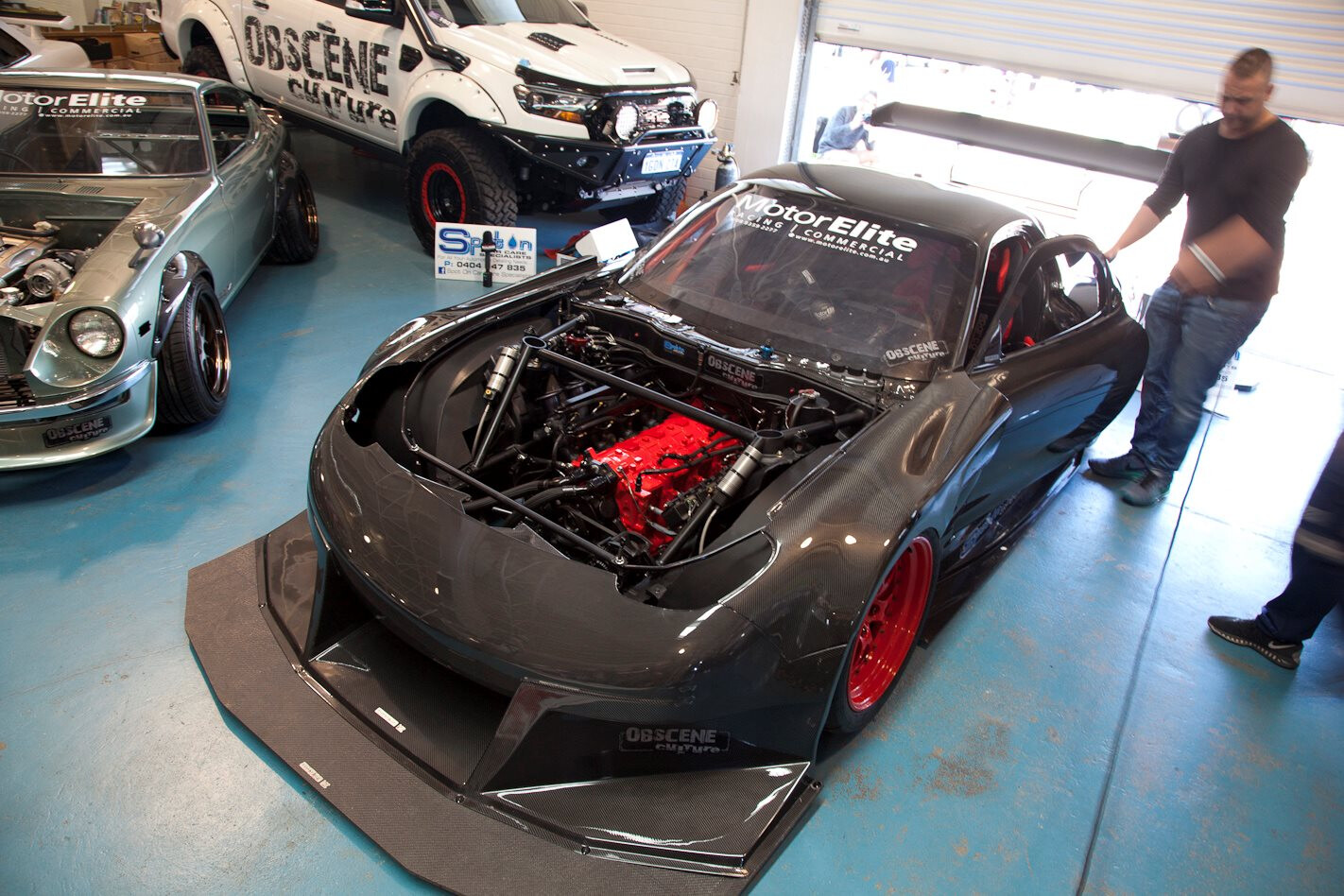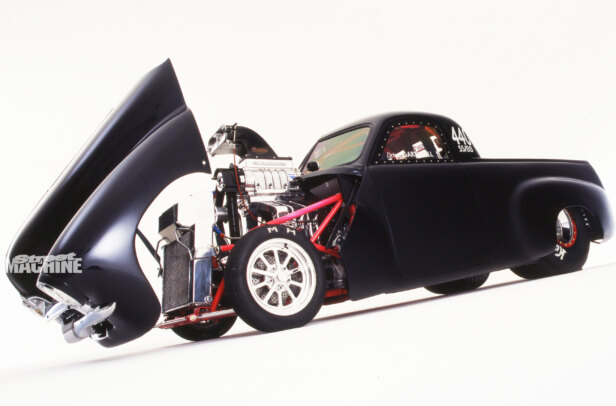THE Mazda rotary engine has been the natural enemy of the V8 for decades, on the street, on the drag strip and around the race track. Shaped like a barrel and with an unmistakeable sound when they’re worked, it’s the engine everyone most loves to hate. Yet even the most ardent V8 fan would have to admit, grudgingly, that the rotary is admirably simple in operation, chock full of character and loaded with performance potential.
This article was first published in the July 2013 issue of Street Machine
The most common rotary on the planet is the twin-rotor 13B, though the triple rotor 20B has been popular in drag racing circles for the last couple of decades. Mazda even built the four-rotor 26B for sports prototype racing, taking out the Le Mans 24-hour in 1991.
Of course, 26Bs aren’t exactly thick on the ground, so enterprising Kiwi Warren Overton came up with his own formula for building quad-rotors himself under his Pulse Performance banner, the best-known application of which is in the ‘Mad Mike’ Whiddett drift RX-7.
But if some is good, more is better, right?
“When we came up with the idea for this engine I wanted to build a promotional vehicle to highlight PPRE’s skill set to customers worldwide,” explains Warren. “It was important to start with an old-school ride and this particular car had sentimental value to me because it was the first rotary I ever drove, when I was just 14 years old. My good friend and long-term client Alex had owned the car since he was 13. Alex and I had a shared interest in the finished project so we proceeded to build the car of both our dreams.”
The RX-4 is packing plenty of rubber, but the boys reckon there is room for more if they get serious about hitting the strip
Warren calls his 3924cc six-rotor creation a ‘6B’, but it could also be considered a ‘40B’ using the Mazda naming convention. The modular design of the Mazda rotary made his original four-rotor engine almost as simple as stacking extra rotors on the end of the engine. Most of the parts are genuine Mazda, but it was Warren’s considerable cleverness in hand-fabricating a custom eccentric shaft (think crankshaft), and his mechanism for supporting the extra-long shaft in the factory 13B rotary engine plates (the blue-painted cast iron bits sandwiched between the polished aluminium rotor housings) that made the engine possible.
The intricate headers are made from 1in pipe and while they are not quite equal length, they are within 20mm. Without mufflers, the sound is out of this world!
“After we did the design for the four-rotor, using that same design theory we were able to generate the six-rotor as well,” explains Warren.
From the Mazda spare parts department came six series four RX-7 13B housings, which were treated to the ultimate breathing enhancement for naturally aspirated rotaries – peripheral porting. The drum-shaped engine was then assembled using lightweight, high-compression RX-8 rotors, custom PPRE seals, a custom five-piece eccentric shaft, and modified stationary gears (see breakout opposite for an explanation of how the rotary engine works).
If only Felix Wankel could see this! Six rotors, six throttle bodies and 12 coils make for a tight squeeze in the RX-4’s engine bay. Combustion in the six-rotor happens six times per revolution of the eccentric shaft, unlike a regular twin-rotor, which fires only twice per rev. It has “around 650ft-lb [880Nm] of torque at the wheels and quite a good torque curve that starts very early. Throttle response is truly remarkable,” says Warren
Feeding the heavy-breathing peripheral-port engine are six PPRE/EFI Hardware throttle bodies with custom tapered intakes. A modified Microtech LT16c controls the squirt via 12 550cc injectors, and fires a pair of X6 ignitors and 12 Bosch coils (one per spark plug; two plugs per rotor).
“We wanted to keep the original exterior profile of the vehicle looking stock, but with the tough Pro Street stance to match the powerplant,” says Warren. As a result the Coupe’s pearl midnight blue bodywork was left much as Mazda designed it. But to shoehorn the long, six-rotor engine into where a compact two-rotor once lived, Warren undertook significant modifications to the firewall and transmission tunnel.
Three radiators help the ‘big-block’ rotary to keep its cool, but the limited space left by the monster mill means two of them have to live in the boot, with coolant recirculated via a rear-mounted electric pump system
The angry, lumpy beast, breathing through an unmuffled 6-2-1 system, is best described as effing loud. On a Dyno Dynamics rolling road in ‘shootout’ mode, the RX-4 unleashed 813hp (around 1000 flywheel horses) and enough decibels to make the ears bleed.
Behind the monster six-rotor is a Tremec 600 five-speed with a triple-plate clutch. Inside is mostly RX-4, with a pair of STA race seats, six-point cage and SAAS tiller
“It’s predominantly a street car,” says Warren. “But it’s built tough if we decide to take it down the strip. I’d estimate it’d quite easily do an eight-second quarter mile with that power, and it certainly hooks up; it transfers the weight well.”
The build showcases Warren’s engineering expertise and Alex’s love of the Mazda rotary. It consumed 12 months and around NZ$120,000, but paid off – at the Mazda’s first official outing it took out Best Engineering, Best RX-4, Best Paint and Best RX. A forced-induction set-up is somewhere in the Mazda’s future, but before then Alex plans to get out and enjoy his home-honed monster on the road.
“We’ve built it within the guidelines of hobby car building in New Zealand, which basically means we can get it certified with the modifications we’ve got,” says Warren. “We intend building a much quieter exhaust system – we’ve actually lifted the floor on the passenger’s side to accommodate some pretty serious muffling under there. There’s a few minor things to do such as fit a horn … other than that she’s pretty ready to go on the street.”
SPIN CLASS
BECAUSE its internals rotate rather than reciprocate, and because it has a small number of moving parts, German engineer Felix Wankel’s rotary engine is inherently smooth, with a hunger for revs and plenty of potential for power.
Many manufacturers have tried it but only Mazda persisted, and eventually made the mass-production Wankel engine a success. The Mazda rotary was in continuous production from the 1967 Cosmo Sport 110S until 2012 in the RX-8.
The engine’s apex seals at each corner of its roughly triangular-shaped rotors follow the internal shape of the rotor housing, which can be pictured as an oval with its sides pinched slightly. As the rotor traces its unusual path – termed epitrochoidal in geometry speak – it opens and closes ports like a two-stroke, and creates three moving combustion chambers, its axis of rotation controlled by stationary gears, and combustion forces transferred to an eccentric shaft, which is equivalent to the crankshaft in a piston engine. Simple, eh?
ALEX SIGLEY
MAZDA RX-4
Colour: Midnight Blue Pearl
DONK
Type: PPRE six-rotor, peripheral port
Eccentric shaft: PPRE five-piece
Induction: EFI Hardware throttle bodies, PPRE intake
Injectors: 12x550cc
ECU: Modified Microtech LT16c
Ignition: Twin X6 ignitors, 12 Bosch Tec coils
Fuel system: Twin Bosch 044 pumps, Malpassi regulator, Bosch Motorsport filters
Cooling: Triple radiators, electric water pump
SHIFT
Box: Tremec 600
Clutch: Tilton triple plate
Diff: Moser alloy 9in, 35-spline Moser axles, 4.1:1
BENEATH
Front: Koni shocks on modified uprights
Rear: Four-link, QA1 double-adjustable shocks
Brakes: Series V RX-7, Wilwood four-pot calipers (f), Wilwood (r), Tilton pedal box
ROLLING STOCK
Rims: Weld Alumastar 5½in (f), 12in (r)
Rubber: Mickey Thompson Sportsman




Comments